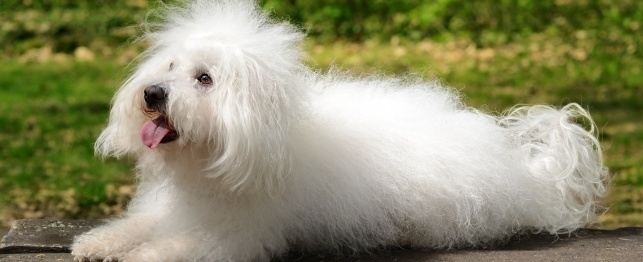

Dogs
While the small, accessory-type dog is so admired and people are eager to have unique dogs of this type, such as the "designer" dogs, it may be an ideal time for the Bolognese (a small, rare breed) to gain popularity.
The Bolognese is part of the Bichon family group and is also referred to as the Bichon Bolognese. As of 1999, the Bolognese is a member of the AKC's miscellaneous class in the Foundation Stock Service (FSS). The FSS is the AKC's record-keeping system for rare breeds which are not yet fully AKC recognized.
The Bolognese originated in Bologna, Italy as early as the 11th or 12th Century. During the Renaissance, the Bolognese was a very special gift amongst nobility. The breed eventually lost popularity and nearly faced extinction. The hard work of several dedicated breeders, particularly Gian Franco Giannelli, saved the breed.
The Bolognese is very similar in appearance to the Bichon Frise, small and stocky with white, loose ringlet hair. His woolly coat does not have an undercoat, sheds minimally, and is considered to be low-allergen. He stands 10 to 12 inches tall at the shoulders and weighs 4.5 to 9 pounds.
Though not as active as the Bichon Frise, the Bolognese can be playful and friendly. This very serious, companion dog is dedicated to and often possessive of his family and timid around strangers. The Bolognese is intelligent and eager to please.
Because he is a very small dog, it is important that this breed lives primarily indoors. Small children may not be ideal around this dog, as his size makes him prone to injury from rough handling. Apartment life or living with someone who is less active, such as the elderly, would be adequate for this dog. This breed generally does well around other pets.
Though this dog sheds very little to not at all, regular brushings are important to prevent matting and monthly professional grooming sessions are recommended.
The Bolognese is quite responsive to obedience training as he is eager to please. Socialization at an early age is crucial, as this breed is often shy toward strangers.
This breed is considered to be a healthy breed with no common ailments; however, due to his close relation to the Bichon Frise the Bolognese may share some of his health problems.
The life expectancy of the Bolognese is approximately 14 years.
We realize that each dog is unique and may display other characteristics. This profile provides generally accepted breed information only.
Copyright © 2005-2016 Pet Information All Rights Reserved
Contact us: www162date@outlook.com